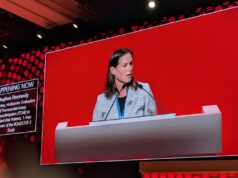 Boston Scientific Corporation has announced the presentation of positive five-year pooled results for the Intracept intraosseous nerve ablation system, measuring outcomes across three clinical trials in the treatment of vertebrogenic low back pain. The data were presented at the 2024 American Society of Pain and Neuroscience (ASPN) conference (11–14 July, Miami, USA).
Boston Scientific Corporation has announced the presentation of positive five-year pooled results for the Intracept intraosseous nerve ablation system, measuring outcomes across three clinical trials in the treatment of vertebrogenic low back pain. The data were presented at the 2024 American Society of Pain and Neuroscience (ASPN) conference (11–14 July, Miami, USA).
A Boston press release details that more than 30,000 patients have now been treated with the Intracept system, which utilises the only US Food and Drug Administration (FDA)-cleared device for the treatment of vertebrogenic low back pain—a distinct type of pain caused by damage to vertebral endplates between the disc and the vertebral body.
“These aggregated five-year results further demonstrate the safety, efficacy and reproducibility of the Intracept system in providing lasting vertebrogenic pain relief,” said Ray Baker, vice president and chief medical officer, Neuromodulation, Boston Scientific. “The data included at ASPN also underscore our focus on delivering a portfolio of clinically proven solutions that transform the lives of patients with chronic pain.”
Five-year outcomes with the Intracept system from three long-term follow-up studies utilised the patient-reported Oswestry Disability Index (ODI) and visual analogue scale (VAS), comparing these scores to baseline across 249 patients. Key findings were as follows:
- Clinically and statistically significant improvements in pain (measured by VAS on a 0–10 scale) and function (measured by ODI on a 0–100 scale) from baseline to five years
- Some 83% of patients reported a ≥2-point reduction in VAS from baseline (p<0.0001)
- Some 78% of patients had a ≥15-point reduction in ODI from baseline (p<0.0001)
- Nearly 66% of patients had a 50% or more reduction in pain relief (p<0.0001)
- Nearly one-third of patients reported being 100% pain free after five years (p<0.0001)
In total, ASPN 2024 saw 15 abstracts and posters presented that featured Boston’s clinical data. An additional data highlight came from a US multicentre, observational, real-world study of patients being treated with Fast-Acting Sub-perception Therapy (FAST) via the company’s WaveWriter Alpha spinal cord stimulation (SCS) system.
In the study, patients who preferred the use of FAST therapy achieved durable and robust pain relief out to 12 months of follow-up (n=89), while outcomes among 289 patients assessed at mean final follow-up included a 5.5-point reduction in numeric rating scale (NRS) pain score, from 7.8 to 2.3 (p<0.0001), on a 0–10 scale. The study also observed a responder rate of 91% of patients reporting a 50% or greater reduction in pain, and an NRS pain score of ≤2 being reported in 61% of patients.
A further European study assessing clinical outcomes using Boston’s FAST-SCS therapy for chronic pain saw data reported from a multicentre, observational case series of patients permanently implanted with a FAST-enabled SCS system. Significant improvements in disability (29-point reduction in ODI) and quality of life were observed in patients assessed at mean final follow-up, and—at the 12-month and 24-month follow-up visits (n=86 and 52, respectively)—those patients had 5.1-point and 5.6-point NRS reductions (p<0.0001) in overall pain.
Finally, a prospective, multicentre, single-arm study utilising an SCS system designed to engage surround inhibition using FAST therapy led to the reporting of outcomes measuring the effectiveness of FAST and additional SCS therapy options for chronic pain in 42 enrolled subjects. Patients treated with FAST in the study achieved significant and durable sub-perception pain relief with associated improvement in disability and satisfaction up to 12 months of follow-up, as well as a mean five-point reduction in verbal rating scale (VRS) for low back pain (p<0.0001) at 12-month follow-up; a responder rate of 91% of patients reporting a 50% or greater reduction in pain; and sub-perception pain relief being achieved within minutes of FAST activation, with a mean time to pain relief (≥50%) of 2.6 minutes.










